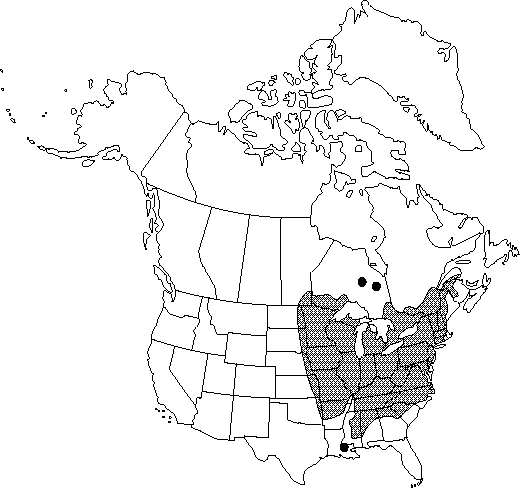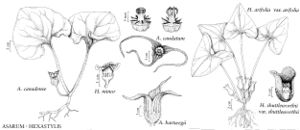Asarum canadense
Sp. Pl. 1: 442. 1753.
Rhizomes horizontal, shallow, internodes 1.0-3.5 cm. Leaves: petiole 6-20 cm, crisped-hirsute. Leaf blade not variegate, cordate-reniform to reniform, 4-8(-20) × 8-14(-21.5) cm, apex rounded or obtuse; surfaces abaxially appressed-hirsute, usually sparsely so, adaxially appressed-hirsute, at least along main veins, marginal hairs perpendicular to margin or curved toward apex. Flowers erect or ascending; peduncle 1.5- calyx tube cylindric, externally tan or purplish, hirsute (often densely), internally white or pale green, occasionally mottled with purple, with white or purple hairs; distal portion of sepal spreading or reflexed at anthesis, 6-24 mm, apex apiculate to acuminate or filiform-attenuate, abaxially green or purple, hirsute, adaxially purple, puberulent with crisped purple or pale hairs; pollen sacs 1-1.5 mm, sterile tip of connective on inner stamens purple, 0.5-1 mm, shorter than or about as long as pollen sacs. 2n = 26.
Phenology: Flowering spring–early summer (Mar–Jul).
Habitat: Understory of deciduous (rarely coniferous) forests
Elevation: 0-1300 m
Distribution

Man., N.B., Ont., Que., Ala., Ark., Conn., Del., D.C., Ga., Ill., Ind., Iowa, Kans., Ky., La., Maine, Md., Mass., Mich., Minn., Miss., Mo., Nebr., N.H., N.J., N.Y., N.C., N.Dak., Ohio, Okla., Pa., S.C., S.Dak., Tenn., Vt., Va., W.Va., Wis.
Discussion
The rhizomes of Asarum canadense are occasionally used for seasoning. Handling the leaves is said to cause dermatitis in some people.
Native Americans used Asarum canadense medicinally to treat flux, poor digestion, swollen breasts, coughs and colds, typhus and scarlet fever, nerves, sore throats, cramps, heaves, earaches, headaches, convulsions, asthma, tuberculosis, urinary disorders, and venereal disease; as a stimulant, a seasoning, and a charm; and to strengthen other herbal concoctions and heighten appetite (D. E. Moerman 1986).
Selected References
None.
